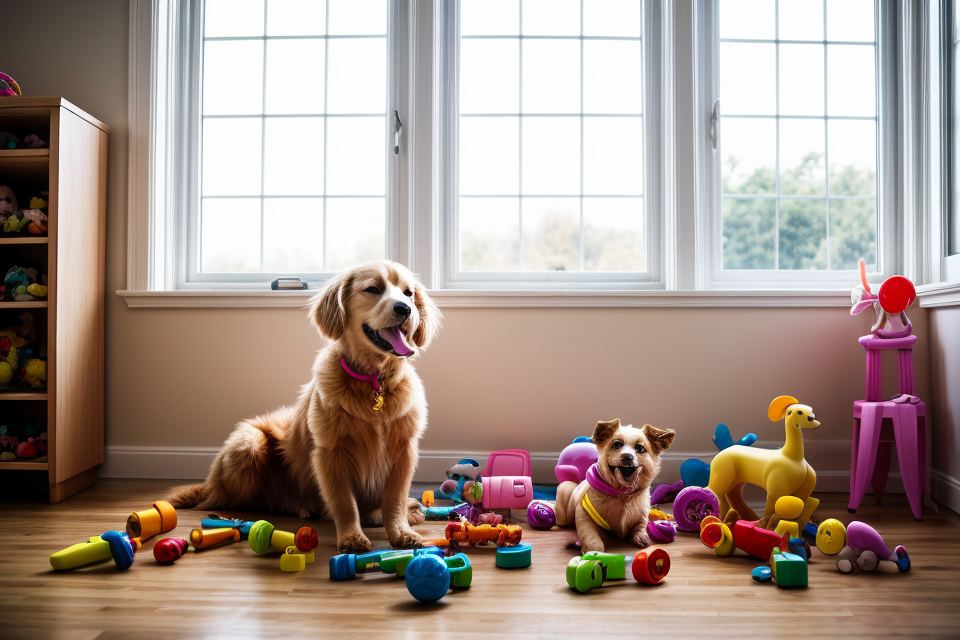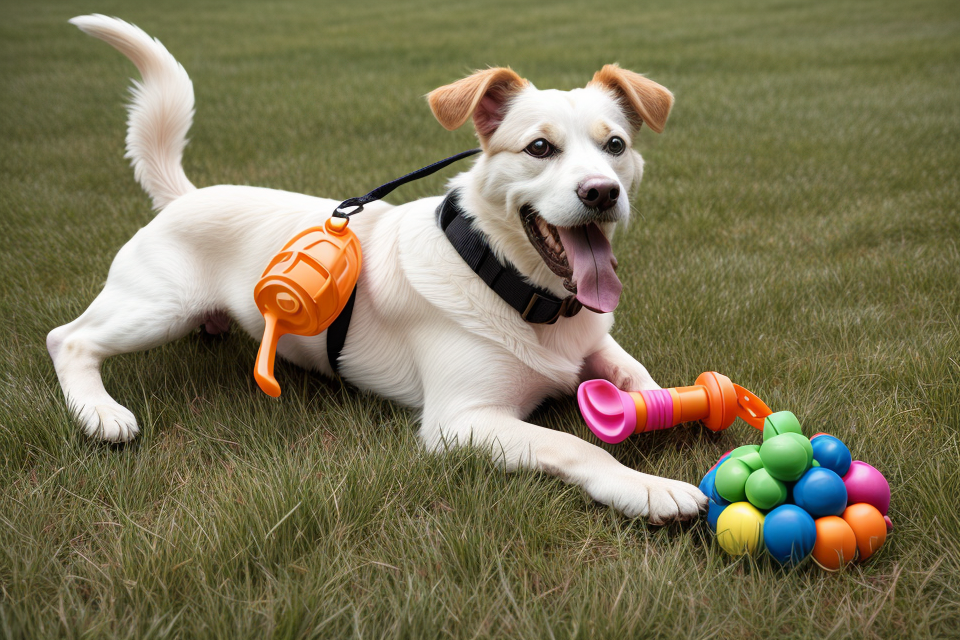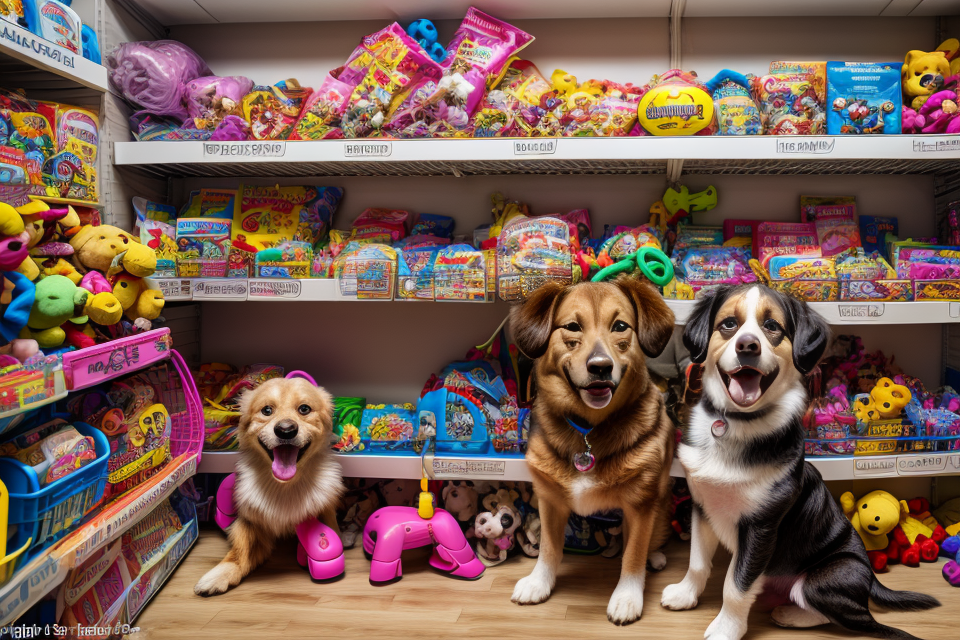Do you have a furry friend who can’t get enough of their toys? While it’s great to see your dog having fun, too many toys can lead to overstimulation. But what exactly does that mean for your furry companion? In this article, we’ll explore the topic of canine overstimulation and how it can affect your dog’s behavior and well-being. So, if you’re curious to learn more about how many toys is too many for your dog, read on!
The Impact of Multiple Toys on Your Dog’s Behavior
How Many Toys is Too Many for Your Dog?
Factors affecting a dog’s tolerance for toys
When it comes to determining how many toys is too many for your dog, several factors must be considered. These include:
- Age: Puppies and senior dogs may become overstimulated more easily than adult dogs.
- Breed: Different breeds have varying energy levels and play styles, which can impact their tolerance for toys.
- Individual temperament: Some dogs are naturally more active or easily excitable than others, which can affect their ability to handle multiple toys.
Signs of overstimulation in dogs
If your dog is playing with too many toys, they may exhibit signs of overstimulation, such as:
- Becoming agitated or frustrated while trying to choose which toy to play with
- Dropping or destroying toys
- Ignoring previously favorite toys
- Pacing or restlessness
- Whining or barking
It’s important to pay attention to these signs and remove some of the toys to prevent your dog from becoming overstimulated. Additionally, rotating toys frequently can help keep them interested and prevent boredom.
The Importance of Rotating Toys
While providing your dog with multiple toys may seem like a great idea to keep them entertained, it is important to be mindful of the potential negative effects of overstimulation. Rotating toys is one effective way to prevent this from happening.
Mental and physical benefits of rotating toys
Dogs are naturally curious and love to play with toys. Rotating toys keeps their environment fresh and stimulating, which helps to prevent boredom and destructive behavior. Rotating toys also helps to prevent dogs from becoming too attached to one particular toy, which can lead to possessiveness and aggression towards other dogs or people.
In addition to preventing boredom and destructive behavior, rotating toys also has physical benefits. Dogs need mental and physical stimulation to stay healthy and happy. Rotating toys provides both, as it encourages dogs to use their problem-solving skills and physical abilities in different ways.
Tips for rotating toys effectively
To effectively rotate toys, it is important to follow a few simple tips:
- Have a variety of toys: Rotate between different types of toys, such as chew toys, fetch toys, and puzzle toys. This will keep your dog engaged and interested in their toys.
- Rotate frequently: Rotate toys every few days to keep your dog’s environment fresh and stimulating.
- Don’t overwhelm your dog: Don’t give your dog too many toys at once. Start with a few and gradually increase the number as your dog becomes more accustomed to rotating toys.
- Supervise playtime: Supervise your dog during playtime to ensure that they are not becoming overly possessive or aggressive with their toys.
By following these tips, you can ensure that your dog stays mentally and physically stimulated, while also preventing the negative effects of overstimulation.
Understanding Your Dog’s Play Styles
Encouraging Positive Play Behaviors
When it comes to your dog’s playtime, it’s important to promote positive behaviors and habits. Here are some ways to encourage your furry friend to engage in healthy play:
Promoting healthy play habits
One of the best ways to encourage positive play behaviors is to provide your dog with a variety of appropriate toys. This will help prevent boredom and keep your dog engaged in healthy play activities. Make sure to regularly rotate your dog’s toys to keep things interesting and prevent destructive behavior.
Another important aspect of promoting healthy play habits is to supervise your dog during playtime. This will help prevent any accidents or injuries and allow you to intervene if necessary. It’s also a good idea to provide your dog with plenty of opportunities for exercise and mental stimulation throughout the day, not just during playtime.
Training techniques to develop good play manners
In addition to providing appropriate toys and supervising playtime, training is key to developing good play manners in your dog. Start by teaching your dog basic obedience commands such as “sit,” “stay,” and “leave it.” This will help prevent accidental biting and rough play, as well as teach your dog to respect boundaries.
Another important training technique is to use positive reinforcement. Reward your dog with treats, praise, or playtime when they engage in appropriate play behaviors. This will encourage your dog to continue behaving in a positive manner during playtime.
It’s also important to teach your dog to play gently. This can be done through positive reinforcement and by providing plenty of opportunities for your dog to engage in gentle play. Encourage your dog to use their mouth in a gentle manner by providing soft toys and treats that can be easily grasped with their mouth.
By promoting healthy play habits and using training techniques to develop good play manners, you can help ensure that your dog has a fun and safe playtime experience.
The Risks of Overstimulation in Dogs
Signs of Overstimulation
Physical Signs of Overstimulation
When a dog is overstimulated, they may exhibit physical signs such as:
- Panting heavily
- Rapid breathing
- Drooling excessively
- Trembling or shaking
- Excessive barking or whining
- Destructive chewing or biting
- Accidents in the house
These physical signs indicate that the dog is feeling overwhelmed and may be struggling to cope with the level of stimulation they are experiencing.
Behavioral Signs of Overstimulation
In addition to physical signs, overstimulation can also manifest as behavioral signs in dogs. These may include:
- Aggression or snapping at other dogs or people
- Withdrawal or hiding
- Separation anxiety
- Over-attachment or clinginess
- Restlessness or inability to settle down
- Escaping or attempting to escape from the current environment
It is important to recognize these signs of overstimulation in dogs, as they can indicate that the dog is feeling stressed or overwhelmed and may need a break from the stimulating environment.
The Link Between Overstimulation and Aggression
- How overstimulation can lead to aggression
When dogs are overstimulated, they can become overwhelmed and stressed, which can manifest in aggressive behavior. This may be due to a dog’s inability to cope with the excessive stimulation, leading to frustration and a resulting display of aggression. Overstimulation can occur when a dog is presented with too many toys or new objects to explore simultaneously, causing sensory overload.
- Strategies to prevent overstimulation-induced aggression
To prevent overstimulation-induced aggression, it is essential to manage a dog’s environment and ensure that they are not exposed to an excessive amount of stimuli. Here are some strategies that can help:
- Gradual introduction of new toys: Introduce new toys gradually to avoid overwhelming your dog. Start with one new toy at a time and observe your dog’s reaction before introducing another.
- Rotating toys: Instead of providing your dog with numerous toys at once, rotate their toys on a regular basis. This will help keep things interesting and prevent boredom, while also avoiding overstimulation.
- Providing appropriate chew toys: Instead of giving your dog human-made toys, provide them with appropriate chew toys made specifically for dogs. These toys are designed to be safe and durable, and can help satisfy your dog’s natural instinct to chew.
- Supervising playtime: Always supervise your dog during playtime, especially when they are interacting with other dogs or children. This will help you monitor their behavior and intervene if necessary.
- Offering breaks and relaxation time: Make sure your dog has adequate breaks and relaxation time throughout the day. This will help prevent overstimulation and allow them to rest and recharge.
By following these strategies, you can help prevent overstimulation-induced aggression in your dog and ensure that they are happy and well-adjusted.
Managing Your Dog’s Toy Collection
Organizing Toys for Optimal Stimulation
When it comes to managing your dog’s toy collection, organizing the toys for optimal stimulation is key. Here are some tips to help you create a balanced toy collection and encourage responsible play:
- Creating a balanced toy collection
- Diversify the types of toys in your dog’s collection. Include a mix of plush toys, interactive toys, and puzzle toys to keep your dog engaged and stimulated.
- Consider your dog’s age, size, and play style when selecting toys. Puppies, for example, may be more interested in chew toys, while older dogs may prefer puzzle toys that challenge their problem-solving skills.
- Rotate your dog’s toys regularly to keep them interested and prevent boredom.
- Storing toys to encourage responsible play
- Keep a supply of toys in different areas of your home, such as the living room, bedroom, and backyard. This encourages your dog to play in different environments and helps prevent over-stimulation.
- Store toys in a designated area or toy box to help your dog learn to retrieve and play with the toys on their own. This also helps prevent over-stimulation by allowing your dog to play with toys one at a time, rather than giving them an entire collection to play with at once.
- Consider using durable, indestructible toys that can withstand heavy chewing and rough play. This helps prevent accidents and keeps your dog safe while they play.
Donating or Discarding Unused Toys
Regularly evaluating your dog’s toy collection is essential to ensure that your furry friend is not overwhelmed by an excessive number of playthings. Too many toys can lead to confusion, aggression, and other behavioral issues in dogs. Here are some tips for donating or discarding unused toys:
- Assess your dog’s play preferences: Take note of the toys that your dog consistently plays with and enjoys the most. Keep these toys in a prominent place and regularly rotate them to keep things interesting.
- Donate gently used toys: If you have toys that your dog no longer plays with, consider donating them to a local animal shelter or rescue organization. This is a great way to give back to the community and provide joy to other dogs in need.
- Dispose of damaged toys: If a toy is damaged, torn, or missing pieces, it’s best to dispose of it properly. Damaged toys can pose a choking hazard or cause injury to your dog.
- Sell or trade toys online: If you have toys that are still in good condition but that your dog no longer plays with, consider selling or trading them online. There are many online platforms where you can sell or trade used toys, such as Facebook Marketplace or Petfinder.
By following these tips, you can keep your dog’s toy collection manageable and ensure that your furry friend is always happy and content with the toys they have.
Providing Alternatives to Toys
Interactive Playtime Activities
Dogs are known to be man’s best friend, and it’s important to maintain a strong bond with them. One way to do this is by engaging in interactive playtime activities without relying solely on toys. Here are some examples of activities that can strengthen the bond between you and your furry friend while also providing mental stimulation.
Engaging in play without toys
- Obstacle course: Create an obstacle course using household items such as pillows, cushions, and furniture. This will challenge your dog to navigate through the course and use their problem-solving skills.
- Treasure hunt: Hide treats or toys around the house and let your dog sniff them out. This will improve their sense of smell and encourage them to use their natural instincts.
- Tug of war: Grab a piece of cloth or a rope and engage in a game of tug of war with your dog. This will satisfy their natural prey drive and provide mental stimulation.
Teaching tricks and games
- Teach your dog new tricks: Spend time teaching your dog new tricks such as “sit,” “stay,” “shake,” and “roll over.” This will not only strengthen your bond but also provide mental stimulation for your dog.
- Scent work: Introduce your dog to scent work by hiding treats or toys and letting them sniff them out. You can also hide items in different rooms and let your dog search for them.
- Food puzzles: Provide your dog with food puzzles such as a “Kong” toy filled with peanut butter or cheese. This will challenge their problem-solving skills and keep them mentally stimulated.
Overall, engaging in interactive playtime activities without toys and teaching your dog new tricks and games can provide mental stimulation and strengthen the bond between you and your furry friend.
Mental Stimulation Beyond Toys
While toys are a great way to keep your dog mentally stimulated, there are other forms of mental stimulation that can be just as effective. By exploring these alternatives, you can provide a more well-rounded and engaging environment for your furry friend.
- Enriching your dog’s environment: One way to stimulate your dog’s mind is by creating an environment that encourages exploration and problem-solving. This can be achieved by providing your dog with access to different textures, surfaces, and materials, such as ropes, tunnels, and cardboard boxes. By altering the layout of the space or adding obstacles, you can keep things interesting and encourage your dog to use their senses and think creatively.
- Interactive games and exercises: Engaging your dog in interactive games and exercises is another great way to stimulate their mind. For example, you can play hide-and-seek, teach them new tricks, or even create your own games using household items. These activities not only provide mental stimulation but also strengthen the bond between you and your dog.
- Food-based puzzles: Food-based puzzles, such as toys that dispense kibble or treats, can be a fun and engaging way to challenge your dog’s mind. These puzzles require your dog to figure out how to access the food, which helps to satisfy their natural instinct to forage and problem-solve.
- Scent work: Scent work, such as using a scent kit or creating your own scent-based games, can be a great way to stimulate your dog’s mind and nose. This type of activity can help to satisfy your dog’s natural instinct to sniff and search for hidden objects.
- Obedience training: Obedience training is another excellent way to provide mental stimulation for your dog. By teaching your dog basic obedience commands, such as sit, stay, and come, you can help them develop their problem-solving skills and build a stronger bond with you.
By incorporating these alternative forms of mental stimulation into your dog’s routine, you can provide a more well-rounded and engaging environment that satisfies their natural instincts and keeps them mentally stimulated.
FAQs
1. What is dog overstimulation?
Dog overstimulation occurs when a dog becomes too aroused or excited by their environment or activities, leading to behavioral issues such as barking, whining, or even aggression. This can happen when a dog is exposed to too many stimuli at once, such as too many toys or people, and they become overwhelmed and unable to cope with the situation.
2. How can too many toys overstimulate a dog?
When a dog has too many toys, they can become overwhelmed and unable to choose which toy to play with first. This can lead to excessive barking, whining, and even aggression as the dog tries to communicate their frustration. Additionally, having too many toys can create a sense of competition and possessiveness, which can lead to fights between dogs or even aggression towards people.
3. What are the signs of dog overstimulation?
The signs of dog overstimulation can vary depending on the individual dog, but common signs include excessive barking, whining, panting, pacing, and restlessness. Some dogs may also become aggressive or territorial, while others may become lethargic or withdrawn. If you notice any of these signs, it’s important to remove your dog from the situation and provide them with a quiet, safe space to calm down.
4. How can I prevent dog overstimulation?
To prevent dog overstimulation, it’s important to gradually introduce new toys and stimuli into your dog’s environment and to monitor their behavior closely. Limiting the number of toys your dog has access to can also help prevent overstimulation. It’s also important to provide your dog with plenty of opportunities for exercise and mental stimulation, such as walks, hikes, and puzzle toys, to keep them engaged and satisfied.
5. What should I do if my dog is overstimulated?
If your dog is overstimulated, it’s important to remove them from the situation and provide them with a quiet, safe space to calm down. Avoid punishing or scolding your dog, as this can make the situation worse and lead to fear or aggression. Instead, offer your dog a favorite toy or treat to help calm them down, and provide them with plenty of praise and reassurance. Gradually reintroduce them to the situation that caused the overstimulation, starting with small steps and gradually increasing the level of stimulation.



